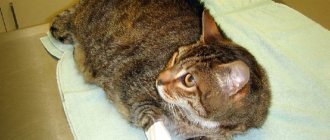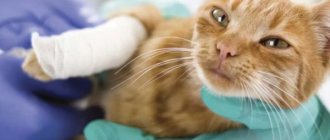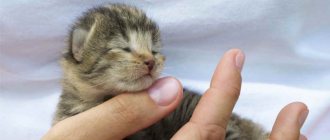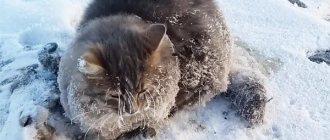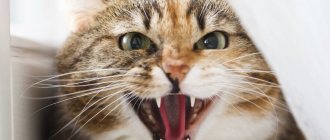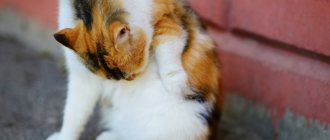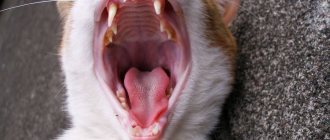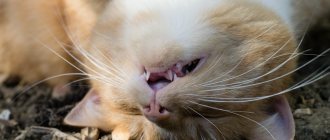Member
Group: Participants Messages: 10 Registration: 11/11/2012 Tails: 1 City of Ivanovo User No.: 19073
Thank you said: 0 times
Hello! Scottish fold cat, 2.5 years old! weight 3.3 kg! The vaccination was overdue because the cat was pregnant and gave birth in June.
They fed them with dry proplan, but when the kittens were born, we began to feed them natural food, and the cat gradually also switched from dry food to natural food, namely chicken and beef soups (I admit, I didn’t give cereals, because she doesn’t eat). So, when there was only one kitten left (the rest were given away), we began to notice that she was limping on her right front leg.
However, this did not affect her activity in any way, she limped only after sleep, and then seemed to be pacing, she and the kitten ran, fought, whatever they did... so the assumption arose that she sprained it during these games. They gave the kitten away and took the cat to the veterinarian. They took an x-ray, the doctor said that he didn’t see anything serious, he prescribed calcium and norocarp. The situation did not change, after 2 weeks we went to the doctor again. They took an x-ray of both paws, the doctor showed me for a long time and persistently that something there in the elbow joint of the right paw was different from the other. prescribed norocarp, artroglycan and noroclav. We drank this for 2 weeks, the cat stopped limping as a result of the painkiller, then when we finished it, it started again a little. Then we began to notice that she was no longer sitting with her right paw raised (as before), but with her left! we thought, maybe she just has a habit of raising her paws when she sits. But then we saw that she was limping on her left paw!
a week later, the lameness got very worse! (I don’t rule out that the right one might also hurt, it’s just that the left one might hurt more). Every day she limped more and more (after rest, then she walked and even ran). Let's go to the doctor. he hesitated, thinking that it could be, then I suggested that it could be due to the fact that we began to feed her natural food (unbalanced) and around this time her paw started to hurt. Then he seized on this idea and said that yes, most likely her calcium-phosphorus balance was disturbed and all because of this (he did not suggest doing tests)! He said to switch back to dry food and take another course of norocarp-arthroglycan. This was yesterday.. I don’t know what to do.. all this somehow doesn’t inspire confidence, the cat is limping badly, it’s difficult for her to even bend down to eat, she’s started moving less! Tell me, please, what can it be.
Presses his paw
Hello! We have a problem! My dog tucks his back left paw. It all started a month ago, right away he didn’t press often, but now he constantly runs on three legs. We noticed this when we switched to dry food. The veterinarian examined the dog and said that there were no dislocations or fractures, most likely the dog lacked calcium. He prescribed us to drink calcium and chondrosamine. We've been drinking it for a week now, but there's no improvement. Please advise what to do!
Hello! We have a problem! My dog tucks his back left paw. It all started a month ago, right away he didn’t press often, but now he constantly runs on three legs. We noticed this when we switched to dry food. The veterinarian examined the dog and said that there were no dislocations or fractures, most likely the dog lacked calcium. He prescribed us to drink calcium and chondrosamine. We've been drinking it for a week now, but there's no improvement. Please advise what to do!
You don't indicate the dog's age! If the dog is young, then we can assume congenital dislocation of the patella or Perthes disease (aseptic necrosis of the femoral head). If the dog is elderly, arthrosis is possible. In general, there are many pathologies, I advise you to show the dog to a good specialist, definitely an ORTHOPEDIST! And as soon as possible, because many pathologies can only be treated surgically.
Hello! We have a problem! My dog tucks his back left paw. It all started a month ago, right away he didn’t press often, but now he constantly runs on three legs. We noticed this when
Source
The cat is limping on his front leg
Three weeks ago the cat began to limp on his left front leg, then a week ago they noticed that when he sits, he tucks his leg in and holds it suspended. He limps more severely after sleeping or lying down for a long time, in general, subjectively, he began to sleep more. He doesn’t refuse food, he runs and plays with the older cat up to the ceiling. During an external examination, no wounds, bites or ingrown claws were found. An x-ray was taken at the veterinary clinic (pictures are attached). In the first picture, the veterinarian pointed out a sharp growth near the joint capsule.
Veterinarian No. 1 recommended Stride Plus as a preventative measure (take according to instructions). He said that these might be the first signs of dysplasia. And that without treatment, the fragment (in photo 1) can get into the joint capsule and injure the joint.
Veterinarian No. 2 said that she was not a specialist in orthopedics, but suggested, as an option, Tolfedin or Chondartron for 7-10 days or Stride Plus, and additionally recommended rest for the animal and an in-person consultation with an orthopedist. Unfortunately, we do not have such specialists in our city.
The cat is kept at home, never goes outside, neutered at the age of 10 months, eats dry Yams food (until 6-7 months he ate dry Royal Canin for the British). The cat had not been sick before. I was vaccinated only with the first two vaccinations with the Nobivac tricat trio vaccine.
None of our veterinarians made any diagnosis, citing the need for some more detailed examination of the joint, during which fluid is injected and an X-ray is taken in several projections under anesthesia.
Elbow dysplasia in cats (this is an inherited condition of the joint). As a therapeutic measure, it will be sufficient to use chondroprotectors (stride or analogues in injections if stride is not effective), as well as losing excess weight.
Elbow dysplasia in cats (this is an inherited condition
Source
CAT HAS BROKEN A PAW
Hello! Help me please! A 9-month-old cat fell from a balcony on the 5th floor. When they brought her in, they noticed that she was not stepping on her right back paw, but now (4 days have passed) she is gradually leaning through the pain. How can I help her? I try to make her move less and bring her food. Maybe you can wrap the paw with a bandage or give some pills? Thank you!
Hello! the cat, as in the previous case, fell from the 5th floor, on the same day they injected anesthesia and applied a plaster bandage, at night she walked away and pulled off the plaster, in the morning they repeated the procedure, more carefully, pulled it off again, called another veterinarian... He put something on her similar to Velcro for shoes, I left it so that it could be changed over time. My wife came home from work and called, all in tears, saying the cat’s paw is bigger than its head, some kind of liquid is leaking... what should I do? what to do? how to treat it and not cripple it? Thanks in advance!!
Yaroslav, we had the same situation, the cat didn’t come home for 3 days. Then they noticed that he could barely walk and did not lean on his FRONT leg. They wrapped it in a bandage and pulled it off. Then, the paw swelled more and more. Then they noticed that some kind of liquid was flowing from the paw. They took it to the vet and they said it was pus or something. They put her under anesthesia and squeezed out this pus. Bandaged. And in short, TAKE TO THE VETERINARINA FAST!
This cannot be said without an x-ray, then no one would do an x-ray, but veterinarians would be invited and they would tell where and what kind of fracture it was. You have already started having complications; a fracture of the humerus cannot be cured without osteosynthesis with a plaster cast. What needs to be done can be understood by having a photograph in hand.
Hello. help me please. my cat broke her right front paw on June 28th, I called the veterinarian, he said it was a fracture and put a plaster on, everything was fine, today is the 6th day the paw is swollen, I called the veterinarian again, he gave her antibiotics and trimmed her leg a little
Source
Causes
There are several reasons why the paw experiences problems, and all of them, as a rule, are traumatic in nature. An exception is inflammation of the joints, which can affect older animals. In such a situation, the paw tightens when moving, and the cat begins to spend more time lying down, trying in every possible way to avoid movements. In other cases, the cat’s inability to stand on its paw is due to injury.
- Bruise or sprain
. Most often in this case the cat does not step on its front paw. The problem is most often encountered by young individuals who are especially active and, at the same time, when jumping, cannot fully calculate the distance between objects and height, and also have not learned to control their body 100%. With such damage, the paw swells and is painful when palpated. Breaking a limb is quite difficult, and the injury is not very common. There are no disturbances in the structure of the bones, which makes it easy to distinguish an injury from a fracture. Treatment will speed up the process of tissue restoration, but even without it, the paw will regain mobility within 7-10 days. There is no need to undergo any medical procedures. - Wound
. If a wound or crack forms on the paw pad, between the toes, or slightly above, the cat stops stepping on the sore limb due to pain when the edges of the wound diverge and fear of infection. On an intuitive level, cats try not to litter the sore spot. It does not matter whether the right or left paw is injured, the treatment is the same. Upon inspection, it is not difficult to identify such a defect. If the paw does not have suppuration and the wound is small, then it is possible to carry out therapy on your own. You should start by washing the damaged area with chlorhexidine and then treat it with levomekol ointment. If possible, apply a bandage. If there is suppuration, everything is much more serious. In such a situation, the cat really injured his paw quite dangerously and needs help. The veterinarian usually gives an injection of antibiotics and cleanses the wound. Without treatment, the paw will not go away at all, and the condition will only get worse. The animal may die. - Splinter or splinter
. It is not uncommon for a cat, without noticing the danger, to step on an object that digs into its paw. After injury, the cat can no longer stand on its paw, as this causes him very severe pain. The affected paw swells and becomes somewhat hotter than healthy ones. After examining it, the owner will most likely be able to determine the cause of the problem. You should not pull out a splinter or splinter on your own if it is large in size. After removing the foreign object from the paw, the wound is treated according to the standard scheme used for ordinary open wounds.
If your pet stops stepping on its paw, then you must immediately determine the cause of the lameness on your paw. Proper treatment returns the animal to good health in the shortest possible time. If necessary, it is always worth involving a veterinarian for therapy.
There are cases when an animal breaks its paw. In such a situation, the cat tries not to step on the broken limb. When there is a crack, the cat sometimes steps on it, but is very lame. You can’t do without a specialist here.
It is impossible to ignore the situation when the cat does not step on its paw. It is important to restore the animal to its normal state as soon as possible.
Cats are particularly mobile. This may also result in some injuries. If a cat is limping on its front leg, the owner should definitely find out the cause of the problem and provide quality treatment to the animal. Without this, there is a high risk that the damage will not go away on its own, and the pet’s condition will continue to worsen. The owner can determine on his own the reason why the front leg is limping only if there are external signs of a violation of the integrity of the limb. In other cases, only a veterinarian can make the correct diagnosis.
the dog is limping on his right leg
You have JavaScript disabled. Some functions may not work. Please enable JavaScript to access all features.
The dog has a swollen toe on his right front paw
About 2-3 weeks ago, an adult schnauzer (14 years old) began lameness on the front right leg. She began to press her when she stood, sat, and began to walk with difficulty, limping. We examined the paw - the second toe from the right was swollen and turned reddish. Doesn't let me touch my nail. She could barely get down from the 5th floor, so they started carrying her downstairs. More or less went up.
Over the phone, a veterinarian I knew prescribed treatment for all the symptoms. They started treating her with human medications - ibuprofen, ortofen. They smeared the finger with levomekol. After 3 days, the pills apparently caused a stomach ulcer (vomiting, black stool). They stopped giving her the pills and took her to another veterinary clinic. She was prescribed tablets for the stomach, began to brew flax seeds, and went on a diet.
Regarding the paw, they gave an injection (they didn’t say which one, anti-inflammatory), took an x-ray (they didn’t give it), they said that there was no fracture or sprain
the dog is limping on its hind leg
German Shepherd, female, 11 months, 26 kg. She has been limping on her right hind leg for a week now. There were no visual reasons for the limping, she didn’t run around, didn’t jump, walked on a leash (in heat). We went to the vet, a photo was taken and a diagnosis was made: sprain of the lateral ligaments of the knee joint. Treatment: no-spa+ analgin 1 ml., dexamethasone, the entire treatment for 7 days. A picture was also taken for dysplasia under anesthesia. Dysplasia is present, but the doctor says that the bones are not in a condition to give such chromate. We also had a consultation with an orthopedic surgeon at the clinic The “center” there said that everything was terrible, the condition of the bones was as if the dog was not a year old, but four, and only surgery to replace the joint with an implant would help, Remadil was prescribed. After such
Source
Recruitment for the group of Veterinary Consultant Assistants is open on an ongoing basis. Bird lovers with warm hearts and nerves of steel! We always have plenty of unpaid hard work for you to do to save feathered patients. Read more here.
The parrot presses its paw
In general, this is the situation. Fischer's lovebird, male, 4 years old. Active, cheerful, sociable, for some reason he began to press his left paw. If anyone has had this or know something about this issue, then I ask you to give advice in order to help my baby in time. Thank you in advance.
How long does he hold it, does he step on it, if he does, do you have the impression that he is in pain? Take it in your hands and examine the paw, claws, and sole. Are the paws different in appearance in size or color when he sits on two paws?
Sits on a stick and raises this paw and holds it in weight. It doesn’t compress, which is also very strange. While moving around the cage, there is no impression that he is in pain - he moves as usual. Same size and color. Unfortunately, I can’t pick it up - it bites a lot.
He eats ready-made mixtures for birds (Padovan, Vitacraft) with the addition of twigs, woodlice, clover, dandelions, boiled eggs to the diet, sometimes I treat him with bread, rarely with cheese. He doesn’t eat food from the table at all, especially salt.
How long ago did this start? Based on the description, it can be assumed that it is painful for him to place his paw on the perch. Let’s say there’s a crack or a nick or a wound on the sole (perhaps that’s why he doesn’t clench his paw into a fist - it hurts) - you won’t find it without inspection.
Are you joking. How do they take large and untamed parrots? Take him with a small towel so that it covers his head, so he can’t see what he’s biting, and examine him. And then, how to treat if you don’t take it in your hands?
Take him with a small towel so that it covers his head, he will not be exposed to
Source
The cat suddenly began to press his back paw
Forum members. Does anyone know what it could be? My cat suddenly began to tuck his left hind paw. She's limping and trying not to step on her. I found him sitting on the table and meowing, but it’s not clear why, because... He is not the only cat we have and can meow when one of them looks at him closely. It seems like he didn’t fall anywhere, didn’t fight. Now he’s lying down, seemingly falling asleep, but somehow restless. Now, while I’m writing this post, I’ve scratched myself with this leg, but I’m still limping. Tell me what this could be, otherwise I’m worried! It's night here, so we're only going to the vet tomorrow.
My cat had this too, he was limping on one leg. The cat is old, I think it’s due to his age. He is 12. How old is your cat? Maybe he just screwed up?
or maybe a splinter, you should see what he has there, my cat once sprained his paw, jumped somehow stupidly, and then limped for a couple of days
╧2 He is about 10 years old. Maybe he turned it up. But I read horror stories on the Internet about heart failure and all that, and I panicked. He is sleeping now, but is still limping today. If the lameness doesn't go away, I'll take him to the vet. Or maybe he really screwed it up.
She examined the paw. There is nothing like that. I called the vet and said that I needed to wait a few days and that it was most likely a sprain.
Why wait so long and what exactly the veterinarian is waiting for is not entirely clear to me personally?? Is it possible to take an x-ray and take an ECG to rule out this or that disease? Yes, just by listening to the cat’s heart, a normal, knowledgeable doctor will understand whether there is some kind of pathology or not, and further studies must be prescribed, or not + examine the paw. What kind of doctor do you have that is so inadequate?
Municipal autonomous educational institution
There is no need to make diagnoses, the picture is quite blurry, so the poor housewife will not get to the veterinarian at all, deciding that everything is completely bad with her pet :) Everything is as simple as an orange: a cat
Source
stretches out the right wing and right paw, then the left wing and left paw. then he tucks one paw in and stands there, what could this mean?
that his paw is worn out!)) ) but in general they are terrible magicians, and they love when people pay attention to them, so they show off! My parrot is a terrible acrobat!
Do not worry. You have already been answered correctly, this is the nature of all birds. Mine behave the same way, and it’s so interesting to watch this process. One of their priests generally does a warm-up once or twice. And you can teach yours, start counting while he is warming up and he will get used to it. Only when he starts to warm up on command should he be encouraged with something tasty.
The body of Orthoptera can be of a wide variety of shapes, but most often it is elongated. The head is relatively large, with a steep or sloping forehead, with developed eyes and ocelli (sometimes there are no ocelli).
The mouthparts are of the gnawing type, directed downward or forward (some are cricket-like). The antennae are elongated, thread-like, bristle-shaped or xiphoid, sometimes club-shaped or of another shape. The pronotum is large, with developed lateral lobes, rectangular on top, and does not cover the head. The mesothorax and metathorax are fused, their pleural sections are sharply subdivided by oblique or vertical sutures into episternum (anteriorly) and epimerum (posteriorly).
A characteristic feature of the entire order is the elongated hind legs with greatly thickened femurs, which provide the ability to jump (in some Orthoptera this ability is lost for the second time). The hind tibiae are armed on both sides with a large number of spines; at the end they usually have 4-6 movable spurs. The front and middle legs are of the running type; the front legs can also be digging or grasping. Fore tibia with hearing organ; in short-whiskered Orthoptera it is lost and developed secondarily in locusts on the first abdominal segment. 1-4-segmented tarsi carried at the end
Why does a cat trample you with its paws?
Why do cats shift from paw to paw? Trampling is a characteristic behavior of domestic cats where the animal alternates between its left and right front paws.
Cats often make these movements on soft surfaces, including pillows, blankets, other animals, and even people. It is not known exactly why cats shift, but there are some hypotheses.
The most popular of them says that kneading has its roots in infancy. While feeding, the kitten will trample the area around the mother cat's nipple to ensure a flow of milk.
In adulthood, a cat will probably stomp when it is happy and in a good mood. It reminds her of the good feelings she had when she was close to her mother. In addition, some cats can lick and even suck the surface on which they trample.
According to another version, kneading takes us back to a time when wild cats allegedly patted the leaves beneath them to make the surface soft for sleeping or giving birth. This behavior now may instinctively mean calming down.
On the other hand, stomping may be a way for cats to mark territory—their glands in their paw pads have a special scent.
To be honest, I didn't know. More than once I have seen my cat trample on a blanket and pillow, and then lie down to sleep on them. Well, who, except the cats themselves, knows which version is more accurate.
My villain cat not only tramples, but also releases his claws. Every morning begins with a massage. And for him this is an obligatory ritual, try not to let him in, he will break through and crush his paws in any way!
My cat loves to trample on the blanket, and also purrs. I agree that in this way the cat is trying to find peace and affection, remembering its mother’s love. At these moments I feel very sorry for her
The first hypothesis, most
Why is the dog limping?
Lameness is any impairment of gait function in one or more limbs. That is, a change in gait, which is expressed by asymmetry in the movement of the limbs due to various dysfunctions of the musculoskeletal system. Lameness is not a diagnosis, but a symptom. But there are many reasons for lameness. These are traumatic damage to the joint and ligamentous apparatus (bruises, sprains, dislocations, fractures, etc.), diseases of the peripheral nerves and spinal cord (paresis, paralysis), circulatory disorders in the extremities (thrombosis), neoplastic formations (bone tumors - osteosarcomas, muscles - fibroids, etc.), genetic diseases (hip dysplasia (large dog breeds - Rottweilers, Labradors, St. Bernards, etc.), dysplasia of the knee joint with dislocation of the knee cap (Toy Terrier, Spitz, Griffon), avascular necrosis of the head hips (Legg-Peters disease), pathological fractures in juvenile osteopathy), inflammatory processes (myositis, osteomyelitis, etc.), vitamin D deficiency (rickets).
First, you need to understand how an absolutely healthy dog moves, one that is not in pain. Her movements will be free, smooth and springy. You need to evaluate the dog's movements at different gaits - walk, trot and, if possible, gallop. You need to evaluate movements not only from the side, but also from the front and back. Walk your dog over damp ground (wet soil, wet sand) to leave paw prints. Measure your stride length. The stride of the affected limb may be shortened, or the paw may move outward or turn inward.
It is important to carefully study the mechanics of movement of a healthy dog. Sometimes lameness is not noticeable at all, barely noticeable. But it is important to notice it in time, determine the cause and take measures to eliminate it, without waiting for complications and deterioration.
In order to establish an accurate diagnosis, it is necessary to determine the type of lameness. Lameness
Source
In the morning everything was fine, I left for 3 hours, and when I returned, the cat was limping. And he doesn’t eat (she offered a tasty treat, which she never refused)
There was contact with a kitten (hugged, licked her, possibly ate from the same bowl), which either had stomatitis or calicivirus. Today we were taken to the clinic. I was planning to go and get some serum for him now.
I found an article on the Internet about this. I quote “In most cases, if a cat or dog is limping on a back or front leg, then there is nothing terribly terrible here, the veterinarian reports, this phenomenon may pass in the near future. Your dog or cat may limp for a few days, then the lameness will gradually subside. If the pain is severe or if the lameness continues for more than three days, you should call your veterinarian. "
What exactly is the question itself? Should I go or is it better to wait? I’ll do the serum tomorrow, now I’m watching the cat. (mouth without ulcers, gums normal)
Maybe it will pass, I wouldn’t waste time, it’s better to be safe than sorry, especially since it simply hurts the cat. Plus there was also contact with a sick kitten, when yours is unvaccinated, you yourself are not sure what the cat is sick with, and you prescribed the serum yourself. I don’t know how you allowed this to happen and what reasons you had for not getting vaccinated.
Evgeniya
Artificial Intelligence (105989) An X-ray may be needed, but the veterinarian will definitely give you recommendations after an in-person examination. Your kitten could. for example, and unsuccessfully jumping off furniture, for example. But there will be no harm from the consultation, and the consultation itself does not cost a lot of money. At the same time, you can get advice about the serum and find out when the vaccine can be given.
Evgeniya
Artificial Intelligence (105989) And what is your opus? The answer says to go to the vet. And “loose-eared British cats are sickly cats, more than straight-eared ones” only means that your vet in the breed is zero, just like you. For the British are only
Source
Prevention
You can prevent lameness in your cat by minimizing the likelihood of injury. The main preventive measures due to which the cat does not limp are:
:
- monitoring what is happening to the animal while walking down the street;
- securely closing windows to protect your pet from falling out;
- adequate feeding – proper nutrition provides the animal with sufficient bone strength and tendon elasticity;
- Be careful when closing the doors so as not to slam the cat.
If a cat is limping, you must definitely understand what happened to him.
A domestic cat, especially if it is a young animal, personifies not only peace and comfort, but is also associated with an active lifestyle. Fluffy pets play with pleasure, jump from heights, run, and frolic.
If a cat is lame on its paw, the owner will immediately notice the problem. The reasons can be very diverse - from minor injury to serious problems with the musculoskeletal system.
Read in this article
limps and curls up his front paw
Dear Doctor! For 3 weeks now, my Chinese Crested Powder Dog has been limping on his front right leg, sometimes tucking it in when he runs. The dog is 3 years old, she is very active, but now she walks like an old lady and lies down during a walk. She seems to have a sprain, she is at home jumps from the floor to the sofa and back or over the threshold of the balcony, without whining. I felt her paw from the shoulder to the claws - everything is fine, there is no pain. Despite the lameness, she continues to jump and even scratches the toy with her sore paw. Weight dogs 4 kg 300g. Please tell me what medications will help her rehabilitate?
Before using medications, you need to determine the causes of lameness and take pictures. It could be a stretch, or it could be the development of congenital joint pathologies in arthrosis.
Thank you very much for your attention. After reading everything on the forum, I began to inject myself subcutaneously with Travmatin and Chondartron. Today, 2 days later, we visited a traumatologist. She carefully felt everything, examined it and found nothing. She didn’t order an x-ray, but asked the assistant to trim the dog’s claws. Then she told me to continue injecting the above-mentioned drugs plus give the dog Artroglycan 1 t/2 times a month. Please tell me, will this treatment help with the hereditary factor that you mentioned?
Even if it helps, I temporarily do not use homotoxicology in my practice; using it, you can only count on a symptomatic, mild and temporary effect.
Hello Vilen Borisovich! Having finally despaired that homotoxicology did not help, and the dog continued to limp and tuck its paw while running, I made an appointment with the head doctor of one of the veterinary clinics, who specializes in traumatology and surgery. He, too, felt his paw,
Source
A cat or dog is limping on a back or front leg
Lameness in animals can be caused by many things: jumping with a bad landing resulting in a broken bone, dislocated joint or sprained ligament. In addition, chronic diseases such as arthritis or hip dysplasia can cause lameness.
In most cases, if a cat or dog is limping on a back or front leg, then there is nothing terribly scary here, the veterinarian reports, this phenomenon may go away in the near future. Your dog or cat may limp for a few days, then the lameness will gradually subside. If the pain is severe or if the lameness continues for more than three days, you should call your veterinarian. However, in most cases, natural home remedies will help your pet get rid of the discomfort when walking, and he will recover quickly. This is what veterinarians advise.
Eliminate painful sensations. Sometimes a cat or dog will limp because it has overexerted its muscles, such as during a vigorous run or a long swim. A homeopathic remedy called arnica helps relieve the pain, says an alternative medicine veterinarian in private practice. For very deep bruises, perennial daisy helps. Use ZOS tablets. Give the animal two or three tablets every few hours until the lameness subsides, but remember, in case of a fracture or dislocation, in no case should you wait several days, you must immediately contact a veterinarian.
Give only one medicine at a time. If Arnica doesn't help, try replacing it with perennial daisy. Both products are sold in some stores and pharmacies or through catalogs. If after two or three the cat or dog does not stop limping, then it is necessary to
Source
Treatment Options
The owner can help the pet on his own only if he discovers an overgrown nail, a splinter, or a small wound on a limb. If lameness is caused by a wound, the wound surface should be thoroughly cleaned of contamination and treated with a disinfectant solution. Even with minor damage to the skin, the animal should be shown to a veterinarian.
If a dislocation is suspected as the cause of the lameness, under no circumstances should you adjust it yourself. If a cat has a swollen paw or is limping, the pet should be taken to a veterinarian immediately.
This should be done quickly, as swollen tissues make it difficult to diagnose and reduce the dislocation. In a clinical setting, if necessary, the animal will be given anesthesia to relieve pain and relieve muscle spasm, and the dislocated joint will be set back into place. After this manipulation, the cat will be given a fixing bandage or splint. In some cases, for dislocations, surgical treatment is resorted to.
For fractures, veterinary specialists use immobilizing bandages and apply plaster. In the case of an open fracture, bone fragments are removed from the wound and, if necessary, surgical excision of the damaged tissue is performed.
Treatment of hip dysplasia and arthrosis of certain joints at first is conservative in nature and includes the use of anti-inflammatory drugs, vitamins, and chondroprotectors. Massage and physiotherapy provide good results. For exacerbations, painkillers are used.
For lameness caused by antiviral and antibacterial therapy. In case of osteodystrophy, the sick pet is prescribed mineral supplements of calcium and phosphorus, vitamin D. Correction of the animal’s diet and dosed ultraviolet irradiation have a good effect.
Arthritis requires complex treatment, which is based on anti-inflammatory, antibacterial agents and painkillers. An important role in the treatment of inflammatory phenomena in the joint is played by adherence to a special therapeutic diet.
If you notice lameness in your pet, you should not hesitate to visit a veterinarian, and also self-medicate. The phenomenon associated with gait disturbance can be caused by serious reasons (dislocations, fractures, joint dysplasia) that require professional help.
X-rays help make a correct diagnosis of a sick animal. In severe cases, veterinary specialists resort not only to conservative treatment, but also to surgery on the joint.
To learn how osteosynthesis is used to treat a tibia fracture in a cat, watch this video:
Probably every cat lover knows that a cat sleeps, lounging on its back, only when it is sure that nothing threatens it. She completely trusts you and exposes her most vulnerable place - her stomach.
And if a cat sleeps with her paws tucked under her, does it mean she is uncomfortable, something is bothering her, she is afraid? Alas, this is not so. A cat does not always sleep with its paws tucked in when it feels bad. It's just that this sleeping position is most likely an instinctive behavior.
We are accustomed to considering a cat as a hunter of small game: rodents, rats, birds, mice. But we forget that in the wild a cat has enemies. And with mother’s milk, cats learn the simple truth that the most vulnerable part of the body is the stomach.
The abdomen contains many vital organs, and injury, even minor, can be harmful and even fatal to a cat.
In addition, sleeping with its paws tucked under itself helps the cat feel more comfortable. In this compact position, it is easier for her to jump up on her paws and either run away or attack. When a cat sleeps on its side, it takes longer for it to assume an upright position.
Most often, a cat sleeps with its paws tucked under itself in an open area: on a closet, refrigerator, bed. This does not mean that she is afraid of something, this is normal behavior for a cat. But inside their house, the box, the cats sleep in a position that is comfortable for themselves, and may even fall apart.
If your cat sleeps with her paws tucked under her and feels normal at the same time, it means she is more comfortable this way. After all, you probably also love sleeping on a huge bed, curled up (like you slept in your mother’s womb).
A healthy cat is an active animal; it still lives exclusively at home or goes out for a free walk. Such activity can lead to a number of injuries, for example, lameness on the front leg. Often this is not an independent disease, but a clear symptom of the presence of other hidden diseases.
ZooForum: Scottish Dog Lame on Front Leg – ZooForum
(others can give advice in a PM, indicating that the advice is not given by a veterinarian. But the forum is not responsible for THESE advice.)
Scottish Dog Lame on Front Leg after Moving
Good afternoon Scottish Fold cat, 1 year old, weight 3500, eats natural food (porridge with meat, cottage cheese, sour cream), I give a breeder for fur, in general there are no deviations, cheerful and active. Yesterday we were transported by train overnight, it was not bad, I slept. He was released this morning and is limping on his right front leg. She didn’t jump, didn’t hit, her paw doesn’t hurt, I felt everything, she doesn’t react, her claws are trimmed. Please tell me what is causing the lameness? Is it possible due to a long period of rest on the road? Thank you in advance!
Our parents are Scottish Fold and British Straight. For some reason I thought it was because of the move, since last time I was transported in the same way on a train, and I limped for several days, then it went away on its own. Here we go again. Unfortunately, X-rays are not possible at the moment. Excuse me, but why is the diet not balanced? I don’t give her everything at once, boil carrots and vegetables separately, for example (rarely), meat separately, sometimes with porridge, and milk. During the week, her diet is very varied. She is also very picky and “buries” almost all her food. He does not eat raw (frozen) meat. I don’t give anything from the table, nothing fried, fatty, salted, smoked. I always cook for her separately. Chicken breast, hearts, liver, lung, lean beef. Rarely fish.
You have a heavy breed, you need additional calcium, vitamins, preferably glucosamine-chondroitin in general. Lameness may be the first sign of chondrodysplasia, an incurable genetically determined fold disease. I would have gotten nervous if I read “British Straight” in the docks - there is no such breed.
We visit the vet regularly and unfortunately
Source
What should the owner do?
Having noticed an uncertain, shaky gait in a furry beauty, the owner must take measures to identify the factors that led to lameness. First of all, it is necessary to examine the sore paw for the presence of foreign bodies in it: splinters, splinters, glass, etc.
If a cat is limping on a front paw, it is necessary to examine and feel the soft tissues of the limb to find out if there are ingrown nails that are interfering with the normal movement of the animal. If overgrown claws are detected, trimming them at home will return the pet to a normal gait.
After examining the paw pads, the injured limb should be carefully examined. , open fractures are easy to notice during visual inspection. In the absence of visible damage, you should feel the joints of the affected limb for swelling, swelling, pain, and increased local temperature.
If a cat has a sore paw, is limping and has dragging limbs, viral calcivirus should be ruled out. With this disease, in addition to gait disturbances, nasal discharge, sneezing, and conjunctivitis are observed. You should not diagnose your pet on your own. Only a veterinarian can determine that lameness is caused by a viral infection based on laboratory tests.
If the problem is not related to a splinter, wound, or visible damage, the owner should take the limping cat to a specialized facility. The most reliable method for diagnosing hidden injuries of joints and bones is x-ray examination.
Using an x-ray, a veterinarian will see displacement of bones during a fracture, dislocations, ruptures of ligaments, disruption of the normal configuration in the joint, phenomena of hip dysplasia and other pathologies of the musculoskeletal system. This method is painless and can be performed in some cases without anesthesia, with light sedation of the animal.
We recommend reading about. You will learn about congenital and acquired heart diseases, symptoms and signs that the owner should pay attention to, diagnosis, treatment and prevention. And more about what to do if your cat has severe salivation.
why does a cat limp on his hind leg?
Kitten limps on its paw
If your kitten is limping on its paw there could be several reasons. First, make sure that the kitten has not pricked its paw. Have your baby sit on your knees and carefully examine the paw pads. If you find no cut, scratch, or foreign body, we continue the inspection.
If your kitten has a scratched paw pad or a foreign body (splinter) stuck there, treat it with chlorhehysidine and call your veterinarian who will advise you on treating the wound.
Remember if your fidget jumped from a height; perhaps he landed unsuccessfully. There are several options: a simple bruise, which will go away on its own over time, a sprain, a crack, and even a fracture, which require immediate medical attention. So if a kitten is limping on its paw due to an unsuccessful fall from a height, give it an injection of traumatin (0.5 ml subcutaneously) and immediately consult a doctor. Usually the doctor takes an x-ray to find out the extent of the injury and, depending on the result of the x-ray of the kitten's lame paw, prescribes treatment.
If the kitten’s paw pads are intact and he did not jump from a height, pay attention to the kitten’s well-being. Perhaps the kitten is limping on its paw due to an infectious disease. Infectious diseases such as calcevirosis can cause lameness in a kitten. In the article “Infectious diseases in cats and kittens” and “If a cat is sick” you will find descriptions of signs of serious diseases in a kitten. If you suspect at least one of the diseases due to which the kitten is limping on its paw, urgently take the baby to the doctor.
There are many diseases and reasons why a kitten is limping on its paw, so the sooner you contact a veterinarian, the faster your baby will receive help, and possibly save his life.
A cat or dog is limping on a back or front leg
Source
Why does the cat sleep
Each of the pet lovers of cats, cats and kittens has noticed that they all have interesting features associated with sleep. They prefer to sleep in different places and in completely unimaginable positions, which is not always clear to those who do not know why this happens.
The article contains the most frequently asked questions on this topic, as well as the answers to them, which allow you to get an idea of what is happening in each specific situation and what needs to be done, if at all, to help your pet sleep more comfortably.
Having studied a bunch of literature, you can find a lot of explanations why a cat sleeps near a person’s head or on his pillow. The main arguments of scientific luminaries boil down to the fact that the cat chooses a place that is more comfortable, warm and safe, from its point of view. However, ardent cat lovers claim that in this way the cat takes away negative energy from them, cures headaches and relieves fatigue.
In any case, since you have decided to keep this furry animal, then you need to take its interests into account, and if the cat likes to sleep over your head, then you need to wean it from this habit calmly and without excessive aggression.
The classic sleeping position - legs tucked under itself - indicates that the animal is alert and ready to wake up at any moment and jump for prey.
The position when a cat sleeps head down, with its head thrown back or its muzzle turned towards the wall, indicates its internal relaxation. those. the animal feels completely safe.
Before the cat was domesticated, it was a nocturnal predator, and its sleep phase occurred during the daytime. The habit of taking a nap during the day has been preserved by the cat to this day, especially when the animal is bored and has nothing to do.
business club yellow cat I don’t want to become a German news columnist, but in an attempt to analyze the cultural characteristics of the people of Germany, I began to write down some events for myself. The US presidential elections are just around the corner
Remember yourself when you feel unwell. How much will you jackpot?
